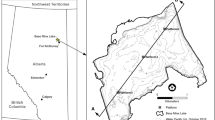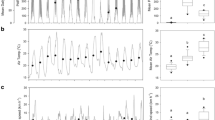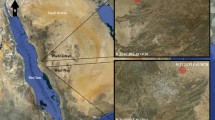Abstract
Nephelometric turbidity and Secchi disc were measured at 16 sampling stations at Lake Carl Blackwell, Oklahoma on 54 dates from 12 February 1982 to 24 January 1983. Measurements of precipitation, wind velocity, effective fetch, water depth, and sediment particle size were also recorded. Turbidity values ranged from 16 to 1 140 NTU and Secchi disc transparency from 2 to 110 cm. Turbidity was generally highest at shallow water sampling stations in the western end and upper arms of Lake Carl Blackwell and decreased with increasing depth. Increases in turbidity during the spring of 1982 were attributed to sediment resuspension and drastic turbidity increases were observed following heavy May rains. Two multiple regression models were developed to predict nephelometric turbidity levels for a given set of climatological and morphometric parameters. One model was based on data for the entire sampling period and is useful in predicting turbidity under high inflow conditions. A second model was derived from data collected prior to periods of heavy rains and is useful in predicting turbidity under more common conditions of moderate winds and rain.
Similar content being viewed by others
References
American Society For Testing and Materials, 1955. Tentative methods for grain-size analysis of soils. 1954 Suppl. ASTM Standards, Part 5: 337–347.
Ayers, J. C., D. C. Chandler, G. F. Lauff, C. F. Powers & E. B. Henson, 1958. Currents and water masses of Lake Michigan. Great Lakes Res. Inst. Publ. 3: 161.
Beach Erosion Board, 1962. Waves in inland reservoirs. Technical Memoir 132, Beach Erosion Corps of Engineers, Washington, D.C., 59 pp.
Brown, C. B., 1941. Factors in control of reservoir silting. J. Am. Wat. Wks. Ass. 33: 1022–1040.
Confer, J. L., G. L. Howick, M. H. Corzette, S. L. Kramer, S. Fitzgibbon & R. Landesberg, 1977. Visual predation by planktivores. Oikos 31: 27–37.
deGroot, A. J., 1976. Heavy metals in the Dutch Delta. In H. L. Golterman (ed.), Interactions between sediments and fresh water. Dr. W. Junk b.v. Publishers, The Hague: 104–107.
Forstner, U., 1976. Metal concentrations in freshwater sediments — natural background and cultural effects. In H. L. Golterman (ed.), Interactions between sediments and fresh water. Dr. W. Junk b.v. Publishers, The Hague: 94–103.
Gloss, S. P., L. M. Mayer & D. E. Kidd, 1980. Advective control of nutrient dynamics in the epilimnion of a large reservoir. Limnol. Oceanogr. 25: 219–228.
Green, D. B., T. J. Logan & N. E. Smeck, 1978. Phosphate adsorption-desorption characteristics of suspended sediments in the Maumee River Basin of Ohio. J. Envi. Qual. 7: 208–212.
Gomez, R. C. & B. G. Grinstead, 1973. Reservoirs of Oklahoma. Oklahoma Dep. Wildl. Cons. Bull, 129 pp.
Grobbelaar, J. U. & P. Stegmann, 1976. Biological assessment of the euphotic zone in a turbid man-made lake. Hydrobiologia 48: 263–266.
Hakanson, L., 1977. The influence of wind, fetch, and water depth on the distribution of sediments in Lake Vattern, Sweden. Can. J. Earth Sci. 14: 397–412.
Hakanson, L., 1981. A manual of lake morphometry. Springer-Verlag, Berlin, 78 pp.
Hemistra, N. W., K. D. Damkot & N. G. Benson, 1969. Some effects of silt and turbidity on behavior of juvenile large-mouth bass and green sunfish. U.S. Dep. Inter., Bur. Sports Fish Wildl. Tech. Pap. 20, 9 pp.
Howick, G. L., J. L. Wilhm, D. W. Toetz & S. L. Burks, 1982. Diagnostic study of Lake Carl Blackwell. Dep. Zool., Oklahoma St. Univ., Stillwater, 132 pp.
Irwin, W. H. & J. H. Stevenson, 1951. Physiochemical nature of clay turbidity with special reference to clarification and productivity of impounded waters. Okla. Agricul. Meehan. Coll. Bull., Arts Sci. Stud., Biol. Ser. 48(4).
Jackson, H. O. & W. C. Starrett, 1959. Turbidity and sedimentation at Lake Chautauqua, Illinois. J. Wildl. Manage. 23: 157–168.
Jewson, D. H. & R. B. Wood, 1975. Some effects on integral photosynthesis of artificial circulation of phytoplankton through light gradients. Verh. int. Ver. Limnol. 19: 1037–1044.
Kennedy, R. H., K. W. Thornton & J. H. Carroll, 1980. Suspended-sediment gradients in Lake Red Rock. Proc. Symp. Surface-water Impoundments, Am. Soc. Civil. Eng., Minneapolis, June, 1980.
Lambert, A. M. & S. M. Luthi, 1977. Lake circulation induced by density currents: an experimental approach. Sedimentology 24: 735–741.
Leonard, E. M., 1950. Limnological features and successional changes of Lake Carl Blackwell, Oklahoma. Ph.D. Diss., Oklahoma St. Univ., Stillwater, 75 pp.
Lind, O. T., 1979. Handbook of common methods in limnology. C. V. Mosby Co., St. Louis, Missouri, 199 pp.
Litherathy, P. & F. Lazlo, 1976. Uptake and release of heavy metals in the bottom silt of recipients. In H. L. Golterman (ed.), Interactions between sediments and fresh water, Dr. W. Junk b.v. Publishers, The Hague: 403–409.
Myers, H. R., 1976. Climatological data of Stillwater, Oklahoma 1893–1975. Agr. Exp. Stn. Rep. P-739, Oklahoma. St. Univ., 29 pp.
Norton, J. L., 1968. The distribution, character, and abundance of sediments in a 3 000-acre impoundment in Payne County, Oklahoma, M.S. Thesis, Oklahoma St. Univ., Stillwater, 76 pp.
Paulet, M., H. Kohnke & L. J. Lund, 1972. An interpretation of reservoir sedimentation: 1. Effect of watershed characteristics. J. environ. Qual. 1: 146–150.
Statistical Analysis System Institute, Inc., 1976. A user's guide to SAS 76. SAS Institute, Inc., Cary, North Carolina, 494 pp.
Schiebe, F. R., J. C. Ritchie & J. R. McHenry, 1975. Influence of suspended sediment on the temperatures of surface waters of reservoirs. Verh. int. Verein. Limnol. 19: 133–136.
Schwartzkopf, S. H. & G. L. Hergenrader, 1978. A comparative analysis of the relationship between phytoplankton standing crops and environmental parameters in four eutrophic prairie reservoirs. Hydrobiologia 59: 261–273.
Serruya, C., 1976. Rates of sedimentation and resuspension in Lake Kinneret. In H. L. Golterman (ed.), Interactions between sediments and fresh water. Dr. W. Junk b.v. Publishers, The Hague: 48–56.
Sheng, W. P. & W. Lick, 1979. The transport and resuspension of sediments in a shallow lake. J. Geophys. Res. 84: 1809–1826.
Small, L. F., 1963. Effect of wind on the distribution of chlorophyll a in Clear Lake, Iowa. Limnol. Oceanogr. 8: 426–432.
Thornton, K. W., J. F. Nix & J. D. Bragg, 1980. Coliforms and water quality: use of data in project design and operation. Wat. Res. Bull. 16: 86–92.
United States Senate Select Committee on National Water Resources, 1960. Pollution Abatement, Committee Print No. 9, 86th Congr., 2nd Session, January, 1960.
Vinyard, G. L. & W. J. O'Brien, 1976. Effects of light and turbidity on the reactive distance of bluegill (Lepomis macrochirus). J. Fish. Res. Bd Can. 33: 2845–2849.
Wallen, I. E., 1951. The direct effect of turbidity on fishes. Okla. Agric. Mech. Coll. Bull., Arts Sci. Stud., Biol. Ser. 48(2).
Walmsley, R. D., 1978. Factors governing turbidity in a South African reservoir. Verh. int. Verein. Limnol. 20: 1685–1689.
Walmsley, R. D., M. Butty, H. Van der Piepen & D. Grobler, 1980. Light penetration and the interrelationships between optical parameters in a turbid subtropical impoundment. Hydrobiologia 70: 145–157.
Author information
Authors and Affiliations
Rights and permissions
About this article
Cite this article
Nolen, S.L., Wilhm, J. & Howick, G. Factors influencing inorganic turbidity in a great plains reservoir. Hydrobiologia 123, 109–117 (1985). https://doi.org/10.1007/BF00018973
Received:
Revised:
Accepted:
Issue Date:
DOI: https://doi.org/10.1007/BF00018973




